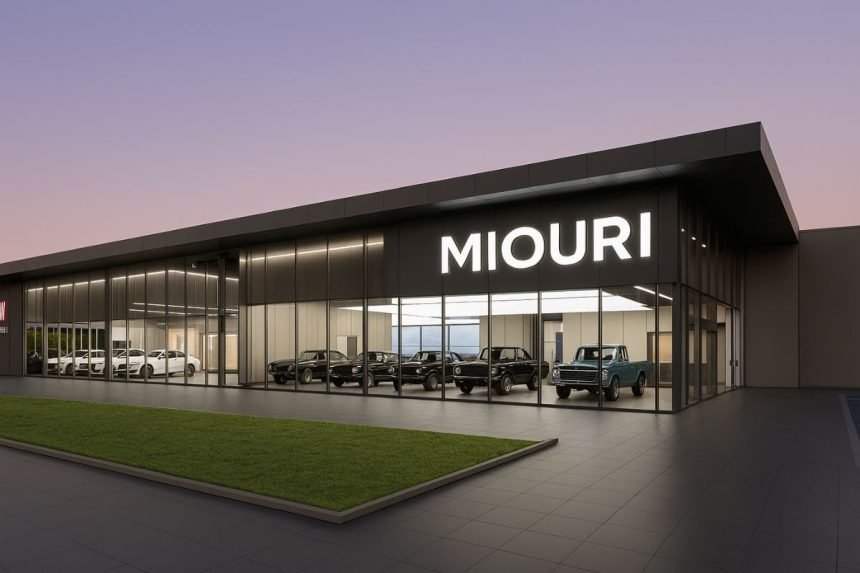A restomod shop owner in Utah is launching a micro-niche carmaker alongside a handful of related initiatives in 2026. Having corralled a couple investors to begin building, Josh Evans will work up to 40 cars a year, and envisions a much longer-term aim of 10 times that, he told Autobody News.
Evans said he’s pre-sold 43 vehicles, expecting to “build the bodies from new sheet metal on our own chassis,” adding crate engines and proprietary parts and paint for “high-tech restomods from the ground-up.”
He said vehicles will carry a manufacturer’s warranty and integrate technology including ADAS and AI.
Alongside this, his brashness barges into areas touching training, paint, parts, performance and people; half those areas as direct revenue streams, the rest in supporting roles, all under Miouri Automotive Group.
That’s his restomod business in Salt Lake City, where he’s scouting parts-making and vehicle-assembly space. The name will become the umbrella group for the sketched out various ventures — as and if they come about.
Miouri is his Sicilian forebears’ family name; Evans said his collision repair lineage goes back some, too.
“I grew up doing classic cars with my grandpa,” he said. “I’ve only ever done classic cars.”
Is ‘The Man and His Dream’ Enough?
Evans ignores his ideas’ intrinsic impossibilities. He says “mythic” a lot. To call Miouri “fantastic” means for him “awesome” rather than “not no way, not no how.”
Josh Evans.
Public pronouncements are based in AI images, grand-scale plans and memes appreciating automotive history: the never-rewarded and nearly forgotten inventor of early windshield wipers, or car company creator Preston Tucker, whose dream didn’t quite become business reality.
“You have to be delusional,” a custom car builder in California who has explored entrepreneurship aligned to shop operations told Autobody News. In a good-to-great way: confidence beyond reason. “It’s a pre-requisite. You have to believe you can do it.”
You can build an electric car company or fly to Mars or live forever.
“And the difference between an eccentric and the world’s richest man is a very fine line,” he said. “It’s only after a project fails or succeeds that everyone gets to say, ‘He was visionary.’” That is, gets to say whether an idea was “insane,” meaning it in a good way, or another kind.
It’s a competitive environment, though which one isn’t? And “restomods is not an original concept,” he said. “Dudes are doing it” and have forever, from Ferrari knock-offs to pre-WWII Bugatti and Alfa Romeos to ‘32 Roadsters.
“It’s really challenging and a lot of guys have tried,” said the Cali custom guy. “There’s literally thousands of moving parts in a car and every one of them has to be perfect.” Not to mention maybe the business side, too.
Evans could be just crazy enough. Just turning 40, he said he’s been at this from his youth and all his adult life. He often ends up talking quality and details, alongside the big ideas.
“We’re adding modern features and comforts” to classic forms, he said. “We consider our cars to be the future.”
The Big Idea is This, and Five More Things
Evans described his plan: making vehicles and parts in Salt Lake City, from 50,000 square feet of leased space. He said the ground-up restomods will sell at three price points, depending on accessories, sold from showroom space or design-your-own online.
These would come from a list of 23 makes and models, whittled down from a list of 68 possible. “It’s based on the most popular cars,” he said, asking custom shops to “name your top-five from what’s available in sheet metal parts.” Sixty-eight would be too much different inventory: “We didn’t want that many options.”
 Computer rendering of a 1970 Dodge Challenger restomod.
Computer rendering of a 1970 Dodge Challenger restomod.
Vehicles span several decades, starting at $200,000 and racing toward a half-million dollars or more. Systems and safety, tires and trim, bespeak top-shelf distilling.
He said the 43 pre-sales are heavy on first-gen Broncos and Mustang fastbacks. With changes in “classics” — modern restomods skewing more to Japanese models, for instance — Evans said Miouri will begin offering those “somewhere between years five and seven.”
For the rest, it’s technician training, custom paints — “where pigment meets prestige” — performance fabrication, a social media setting called Miouri Hot Rod Café and, not just media or marketing, but a “mythmaking engine [to] transform vehicles and lives, blending emotional storytelling, technician culture and cinematic delivery.”
He writes company materials in this vein, and speaks like each area will bring advances in their domains. And it is in a vein: there seems to be something in his blood.
In Francis Ford Coppola’s 1989 film about Tucker’s turmoil, the hero claims things suitable to the scope of his vision: nascent tech, like fuel injection, and crazy talk, such as seatbelts. And, according to the movie, being able to replace entire engines in 20 minutes, though the engines might have been less complex 80 years ago.
Does Life Imitate Art or the Other Way Around?
Evans’ assertion of what this could look like today: Miouri owners “have AI technology in the car so wherever you are, we can tune it from our hub in Salt Lake.” In a social media post, he wrote of AI touching each above area, from making vehicles to chatting about them in the “café.”
But he confesses: “I’m not a technology guy; I build cars.”
 Computer rendering of a “proving ground” that will be used to test Miouri’s creations.
Computer rendering of a “proving ground” that will be used to test Miouri’s creations.
Tucker failed, but those failures drove an industry forward.
As the film’s Howard Hughes says of the Spruce Goose, “Flying isn’t the point.” Tucker tells his team, “It’s the idea that counts, and the dream.” Maybe a business, too.
And if Evans doesn’t end up making cars, the parts and custom paint alone are fairly ambitious for a shop guy.
Evans told Autobody News he began pursuing the company earnestly in February 2023 with two investors, custom shop clients who own construction companies, and are his long-time friends.
This paid for two proof-of-concept practice cars: a ’69 Camaro and a ’57 Bel Air, both convertibles. Of 43 pre-orders, Evans has 43 yet to build — seven less than Tucker built before he lost his whole megillah.
“It gave us a starting point: how do we get from doing a regular restomod, to going ground-up,” he said. “But I knew I’d have to raise more money.”
Buy-ins must come from accredited investors: ones who meet income, net worth and knowledge criteria. That is, people who can stand to lose their money, and know it could happen.
Evans seeks factory space — “we’ve designed the facility; I think we’ve found a site” — and has said Miouri’s “restoration parts catalog is going to print [with] 15,000 SKUs sourced from 2,000 brands.”
An attorney is working on patents and trademarks; two engineers are developing technologies, Evans said. He looks to get each area above rolling in 2026.
“We’re at the point where I want to get the word out,” he said, “starting to sell, building a [public] presence, ordering materials, buying equipment. Time to get into a facility, get up, and get going.”











